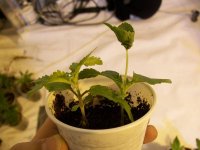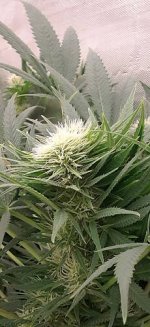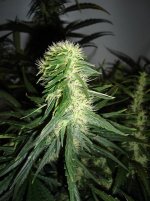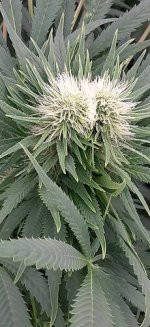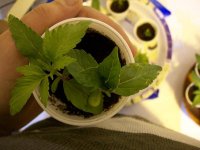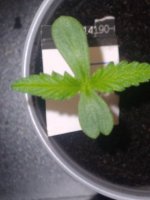You are using an out of date browser. It may not display this or other websites correctly.
You should upgrade or use an alternative browser.
You should upgrade or use an alternative browser.
Lemon Thai s1 and Amnesia x Lemon Thai grow
- Thread starter Jahaze
- Start date
Great pics and write up @Jahaze !
As you say #2 and #4 look the chunkiest... terps sound great, #2 especially sounds exciting with the sandalwood etc - #2 also looks to be a bit more sensitive to the nutes than #4 and the others (maybe more haze in there?).
I'm glad we are getting the lemon/menthol of the ammi as that is quite unique imo when you smell it even if it doesn't sound that exciting on paper.
the astringent smell on #1 may be the 'lemon cleaner' smell from the Lemon Thai.
All of them look like decent plants too! :tiphat;
VG
As you say #2 and #4 look the chunkiest... terps sound great, #2 especially sounds exciting with the sandalwood etc - #2 also looks to be a bit more sensitive to the nutes than #4 and the others (maybe more haze in there?).
I'm glad we are getting the lemon/menthol of the ammi as that is quite unique imo when you smell it even if it doesn't sound that exciting on paper.
the astringent smell on #1 may be the 'lemon cleaner' smell from the Lemon Thai.
All of them look like decent plants too! :tiphat;
VG
thanks @VerdantGreen and @zif . The sweet lemon menthol/alcohol scent on plant #4 smells almost like lemon cologne. I would not mind spraying this stuff on me on a hot summer day just to cool the skin. It has an almost zesty character when i rub my fingers on the flower. A nice bright overwhelmingly lemon smell in nature. I love it. Plant #2 did get some tip burn from me sharing the fish fert from #4 with her. She certainly didn't need it but I wanted to push her a bit to see what would come of it. I feel like those new terps I'm witnessing lately may be related to the nutrient push of last 2 weeks but plant#2 has been different from the beginning with a bubblegum smell that has continued to morph. So far I am really liking this cross and I cant wait to sample some buds...
i would strongly reccomend keeping that runt. its an aneuploid chromosome mutation. these lemon thais have high percentage of polyploids and aneuploid. while polyploids have extra complete sets of chromosomes, aneuploids have partial extra chromosome material be it 1 extra chromosome or pieces of one. the change in gene dosage will create extreme phenotypes for whatever traits that chromosome codes for. heavy resin terps etc. just my 2 centsLemon Thai s1.
the seedlings are coming along except for #4 that is a runt and has some leaf mutations. Im going to give them a dose of mild ewc tea and top dress before they go into bigger containers next week. I have not decided if i should let #4 continue or cull it.. She has shown some growth but this was the seed that I had to help open and took a while to break ground. what do you guys think, keep it or cull it? Anyhow here they are:
View attachment 18093382 View attachment 18093381 View attachment 18093380
Hello @Piff_cat thanks for stopping by and giving your input. It's appreciated. Yeah man, I kept her simply because there aren't many lemon thai s1 seeds around lately and wanted one more plant to choose from. She quickly grew out of whatever that was in the beginning. I hope her difference among the others pays off in flower quality or unique characteristic. I have all four scheduled for flower in the next 7-10 days depending on how they continue to grow in veg.
Thanks for the input, can you tell me why you think LT have a high percentage of polyploids and aneuploids? or where did you read about it... sounds interesting.i would strongly reccomend keeping that runt. its an aneuploid chromosome mutation. these lemon thais have high percentage of polyploids and aneuploid. while polyploids have extra complete sets of chromosomes, aneuploids have partial extra chromosome material be it 1 extra chromosome or pieces of one. the change in gene dosage will create extreme phenotypes for whatever traits that chromosome codes for. heavy resin terps etc. just my 2 cents
VG

hawaiians from 80s used to have this mentholy schnapps thing going on and lemon thai comes from Hawaii according to Dutch Flowers...That menthol/alcohol note can be really pleasant - I've run into it on it's own, but with lemon that sounds phenomenal!
Lovely group of plants, @Jahaze!
Thai Sativa Live Resin......

RMS


RMS

sure you mostly notice it when seeing triploids with 3 nodes consistently , heart of cupped cotyledons, faciation, double flower, flat stem. many thai/vietnam strains(and other plants) can produce unreduced gametes resulting in triploids.(3 full sets of chromosomes) instead of 2 eggs with 1n you get a 2n egg and a 0n egg. this is due to environments have high dli extreme humidity/heat, little daylight length variation .Thanks for the input, can you tell me why you think LT have a high percentage of polyploids and aneuploids? or where did you read about it... sounds interesting.
VG
what starts as a triploid(2n gamete x sperm 1n) gets crazier once inbred/selfed. triploid meiosis is a shit show since theres only 2 poles but 3 sets to segregate. this leads to aneuploids(unequal amounts of chromosomes in progeny) with the most common being a trisomy(3 copies of one chromosome and 2 of all others) but it can also happen with a piece of a chromosome.
this extra genetic material throws off the dosage of whatever the extra part codes for. its usually complex but for example if your extra piece codes for a terpene synthase you will see increases. this can go a step further with additive quantity traits. each time the plant with that extra terpene synthase irregularity is put to a plant with the same extra(either selfed or sib mating) the progeny will produce the sum total of terpene between the 2 plants. a good example is uptown black by piffcoast. the cbh .3 guiaol the brown haze .3 guiaol there progeny .6 guiaol. easy example because guiaol is rare but lots of others out there if interested
these are both lemon thai one is a double flower the other is fasciated. the double flower goes along with a mutation(extra chromosome) called cupped cotyledon which gets progressivly more pronounced when both sides of pedigree carry it. heres amnesia haze x g13 haze(soma) with cupped cotyledon.. the last pic is dalat which has alot of mutated progeny as it resides in the hybrid zone
Attachments
Thanks @Piff_cat , i can't say ive ever seen fasciation in LT or never even in cannabis... seen it plenty of times in other plants and it isn't always genetic.... the cupped cotyledon is interesting (but confusing because the cupped leaf in your pic isn't a cotyledon? )
Bodhi told me the LT was 'all over the place' when he grew it and did the small repro... but i got the impression that he was talking mostly about a lot of intersex traits and autoflowering. (the seeds Bodhi used were F2s afaik and not originals from Dutch Flowers. )
I will be on the lookout for any of these phenomena in the S1s .
VG
Bodhi told me the LT was 'all over the place' when he grew it and did the small repro... but i got the impression that he was talking mostly about a lot of intersex traits and autoflowering. (the seeds Bodhi used were F2s afaik and not originals from Dutch Flowers. )
I will be on the lookout for any of these phenomena in the S1s .
VG

https://www.ncbi.nlm.nih.gov/pmc/articles/PMC156962/pdf/090841.pdf heres a good article on the cupped cotyledon mutation and some better pictures. its a mutation driven by 2 separate genes, cuc1 and cuc2 which causes lack of separation/fusion of coteledons and is due a gene imbalance after the dosage is changed by extra chromosome material. its subtle in a single mutation on one side of pedigree, but once it doubles up or is on both sides you start to see more fusion.
the first pic is outback haze x n. vietnam and came out with one side having 2 smaller cotyledons fused together in heart shape. im going to self this plant and it should create a more extreme heart on both sides or the cup you see in second pic.
then youve got madmacs predator haze mom there next to the lemon thai they both have double flowers but the predator has more extreme fasciation similar to the sannies jack in the last picture there
the first pic is outback haze x n. vietnam and came out with one side having 2 smaller cotyledons fused together in heart shape. im going to self this plant and it should create a more extreme heart on both sides or the cup you see in second pic.
then youve got madmacs predator haze mom there next to the lemon thai they both have double flowers but the predator has more extreme fasciation similar to the sannies jack in the last picture there
Attachments
Lemon Thai s1 week 1 flower.
quick update on the s1 plants as they begin flowering. its been a week and they starting to stretch at a normal rate of growth compared to the Amnesia x LT which i felt stretched a bit more in the 1st week. Perhaps some hybrid vigor at play or maybe the amnesia is just a bigger plant overall? What say you VG? The s1's are going nicely with the exception of some weakness in the branching that makes for floppy colas. I noticed once they were flipped, whenever i brushed against the stems or moved the plants around some branches immediately flop over as if the were damaged. if I leave the plant alone the branches get rigid again but as soon as i start touching or moving the plants i get the floppy stems. its very peculiar and has happened only since they went into flower. I thought perhaps it was that I had some branches tied down too strongly to make for an even canopy and the plant was just stressed at those points but even after I released them from bondage they still sort of wilt with touching or movement. Before anyone say "hey just train a fan on them and it will strengthen the plants", they have had plenty of air movement in both rooms. Also, no other plants are doing this and even the Amnesia x LT crosses didn't have this issue. The three LT plants that were trained all have it and the last plant which was not trained is also showing this trait. its not a big deal i suppose as I will just stake the offending branches but figured I should mention it as part of the test grow. Anyhow, here they are: group shot 1st and then each plant. L-R= 1,2,3,4....sorry for the poor picture quality.

LT #1

LT #2

LT #3

LT #4

quick update on the s1 plants as they begin flowering. its been a week and they starting to stretch at a normal rate of growth compared to the Amnesia x LT which i felt stretched a bit more in the 1st week. Perhaps some hybrid vigor at play or maybe the amnesia is just a bigger plant overall? What say you VG? The s1's are going nicely with the exception of some weakness in the branching that makes for floppy colas. I noticed once they were flipped, whenever i brushed against the stems or moved the plants around some branches immediately flop over as if the were damaged. if I leave the plant alone the branches get rigid again but as soon as i start touching or moving the plants i get the floppy stems. its very peculiar and has happened only since they went into flower. I thought perhaps it was that I had some branches tied down too strongly to make for an even canopy and the plant was just stressed at those points but even after I released them from bondage they still sort of wilt with touching or movement. Before anyone say "hey just train a fan on them and it will strengthen the plants", they have had plenty of air movement in both rooms. Also, no other plants are doing this and even the Amnesia x LT crosses didn't have this issue. The three LT plants that were trained all have it and the last plant which was not trained is also showing this trait. its not a big deal i suppose as I will just stake the offending branches but figured I should mention it as part of the test grow. Anyhow, here they are: group shot 1st and then each plant. L-R= 1,2,3,4....sorry for the poor picture quality.
LT #1
LT #2
LT #3
LT #4
Last edited:
floppy LT plants before above pictures. after about 20mins or so of leaving plants alone they straighten up and look normal..



its acts like a plant we have in the Caribbean called Mimosa pudica or morivivi plant which folds its leaves when disturbed or moved. except here the branching just kinda wilts and then straightens after a while
its acts like a plant we have in the Caribbean called Mimosa pudica or morivivi plant which folds its leaves when disturbed or moved. except here the branching just kinda wilts and then straightens after a while
Last edited:
Thanks for the update @Jahaze ..plants looking good going into flower. The 'temporary floppiness' you decribe.. i sometimes find that, when plants are up-potted, they start producing fast growth and much bigger leaves etc because of the extra root space, and this can result in the new growth being a bit heavy for the old growth underneath which was slightly 'dwarfed' by the smaller pot size. (this can also be made worse if the branches are at an angle from training/pruning rather than vertical) Usually stems will stiffen up and go more woody during flower so hopefully it will sort itself out.
I imagine you give you plants a bit more room than i can give mine, but i also find that my plants are touching and often hold each other up through their proximity.. and then they can flop a bit when they are taken out individually because they lose the support of their neighbours (i also have very good circulation and airflow in my cabs because they are often a bit crowded)
VG
I imagine you give you plants a bit more room than i can give mine, but i also find that my plants are touching and often hold each other up through their proximity.. and then they can flop a bit when they are taken out individually because they lose the support of their neighbours (i also have very good circulation and airflow in my cabs because they are often a bit crowded)
VG
looking at them all, they are pretty uniform really, not as much variation as i was expecting... but early days.
hi verdant green. you may be right about the added weight of the tops as they develop vs the speed the walls can strengthen. those colas are developing quickly after the flip. I took them out again today and as soon as I touched the stems they wilted a bit...not as much as past couple days but they did. I added a small fan in last couple days blowing right on them to help along. In regards to the uniformity of the 4 plants they are close to identical at quick glance for sure. I will get a couple of close up pics in the coming weeks to see if we can pick out any differences.
this is the Amnesia x LT plants #2,4. They are currently at week 8 flower and are fading nicely as they reach the end in the next week or two. I checked trichs with a loupe and I'm noticing about 50% cloudy, about 40% clear and sporadic amber here and there. I think VG's 9 week harvest estimates are spot on since they should finish before week 10 at the current rate. Both plants were very easy grows only requiring some additional food around weeks 5-6 but that is most likely due to the small containers they are in 2gal. pics below with some blurred shots of the buds due to snapping pics while high...sorry.







They both look like lovely plants, and well grown too !
Great that they are finishing too.. they should have a reasonably 'up' high if they take after either of their parents... i tend to chop when i can see mostly cloudy and about 10% amber (which is earlier than some people) and i have found both to be quite heady and lively.. some of the LT can have a really clear soaring high.
VG
Great that they are finishing too.. they should have a reasonably 'up' high if they take after either of their parents... i tend to chop when i can see mostly cloudy and about 10% amber (which is earlier than some people) and i have found both to be quite heady and lively.. some of the LT can have a really clear soaring high.
VG


